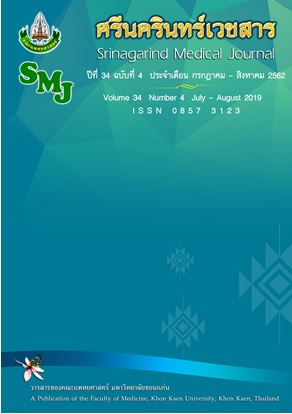Effect of Clitoria ternatea L. Aqueous Extract on Blood Pressure and Oxidative Stress in Renovascular Hypertensive Rats
Keywords:
Clitoria ternatea L., 2K-1C induced hypertensionoxidative stress, oxidative stress, vascular functionAbstract
ผลของสารสกัดน้ำดอกอัญชันต่อความดันเลือดและภาวะเครียดออกซิเดชั่นในหนูความดันเลือดสูงแบบหลอดเลือดไต
ณิศิตา ไชยหงษา1,3, จุฑามาศ วันเพ็ชร1,3, ประภัสสร โพธิ์ตึ1,3, สราวุธ บรรบุผา4, พัชรวิภา มณีไสย1,3, วิไลวรรณ หม้อทอง2, ปาริฉัตร ประจะเนย์2,3, พวงรัตน์ ภักดีโชติ1,3*
1ภาควิชาสรีรวิทยา 2ภาควิชากายวิภาคศาสตร์ คณะแพทยศาสตร์ มหาวิทยาลัยขอนแก่น อ.เมือง จ.ขอนแก่น
3กลุ่มวิจัยหัวใจและหลอดเลือด มหาวิทยาลัยขอนแก่น อ.เมือง จ.ขอนแก่น
4คณะแพทยศาสตร์ มหาวิทยาลัยมหาสารคาม อ.เมือง จ.ขอนแก่น
หลักการและวัตถุประสงค์: อัญชันเป็นสมุนไพรที่ใช้กันอย่างแพร่หลายในเอเชียตะวันออกเฉียงใต้ มีฤทธิ์ต้านการอักเสบและต้านอนุมูลอิสระ การศึกษาครั้งนี้เพื่อตรวจสอบว่าสารสกัดดอกอัญชันสามารถลดความดันเลือดสูง ลดอนุมูลอิสระและปรับปรุงการทำงานของหลอดเลือดในหนูความดันเลือดสูงแบบ 2K-1C หรือไม่
วิธีการศึกษา: หนูแรทเพศผู้ถูกชักนำให้เกิดความดันเลือดสูงโดยหนีบหลอดเลือดรีนอลข้างซ้าย หลังผ่าตัด 3 สัปดาห์ หนูความดันเลือดสูงถูกป้อนด้วยน้ำ และสารสกัดดอกอัญชัน 500 มก./กก. ในขณะที่หนูกลุ่มความดันเลือดปกติถูกป้อนด้วยน้ำ เป็นเวลา 4 สัปดาห์ จากนั้นวัดความดันเลือด การทำงานของหลอดเลือด และภาวะเครียดออกซิเดชั่น
ผลการศึกษา: หนูที่ได้รับสารสกัดดอกอัญชัน 500 มก./กก. ความดันเลือดลดลงอย่างมีนัยสำคัญทางสถิติ(p<0.01) การคลายตัวตอบสนองของหลอดเลือดต่อสารอะซิติลโคลีนลดลงในหนู 2K-1C สารสกัดดอกอัญชันปรับปรุงการตอบสนองของหลอดเลือดต่อสารอะซิติลโคลีน (p<0.01) และลดการสร้างสารอนุมูลอิสระในหนู 2K-1C (p<0.05)
สรุป: สารสกัดดอกอัญชันมีฤทธิ์ลดความดันเลือด ซึ่งสัมพันธ์กับการลดการสูญเสียหน้าที่ของเซลล์ชั้นเอนโดทีเลียม ซึ่งผลต่อหลอดเลือดอาจเกี่ยวข้องกับการเพิ่มไนตริกออกไซด์ จากการลดการสร้างอนุมูลอิสระ
คำสำคัญ: อัญชัน; หนูแรทที่ถูกชักนำให้เกิดความดันเลือดสูงด้วยการหนีบหลอดเลือดรีนอลข้างซ้าย; ภาวะเครียดออกซิเดชั่น; การทำงานของหลอดเลือด
Background and objectives: Clitoria ternatea L. (CT) is known as Anchan in Thai. It has been extensively used for food coloring and a traditional herbal medicine in South East Asia. Several studies reported its biological activities including, anti-inflammatory and antioxidant. This study was to investigate whether CT extract could reduce blood pressure, oxidative stress and improve vascular function in two-kidneys, one-clip (2K-1C) hypertensive rats.
Methods: Male Sprague Dawley rats were induced hypertension by clipping the left renal artery. After three weeks of surgery, hypertensive rats were continuously treated with distilled water and CT extract 500 mg/kg while sham-operated group received distilled water for four weeks. After that rats were anesthetized to measure blood pressure, vascular function and oxidative stress biomarkers.
Results: The rats received CT extract 500 mg/kg significantly decreased systolic blood pressure, diastolic blood pressure and mean arterial pressure (p<0.01). Vasorelaxation responses to acetylcholine (ACh) were blunted in 2K-1C hypertensive rats while treated with CT extract 500 mg/kg significantly improved vasorelaxation response to ACh (p<0.01). In addition, CT extract significantly decreased vascular superoxide production in 2K-1C hypertensive rats (p<0.05).
Conclusion: These findings showed that CT extract had an antihypertensive effect, which associated with improving endothelial dysfunction. Its vascular effect is likely to be increased NO bioavailability as a result of reducing superoxide production.
References
Williams B, Poulter NR, Brown MJ, Davis M, McInnes GT, Potter JF, et al. British hypertension society guidelines for hypertension management 2004 (bhs-iv): Summary. BMJ 2004; 328: 634-40.
Nguyen Dinh Cat A, Montezano AC, Burger D, Touyz RM. Angiotensin II, NADPH oxidase, and redox signaling in the vasculature. Antioxid Redox Signal 2013; 19: 1110-20.
Goldblatt H, Lynch J, Hanzal RF, Summerville WW. Studies on experimental hypertension : I. The production of persistent elevation of systolic blood pressure by means of renal ischemia. J Exp Med 1934; 59: 347-79.
Maneesai P, Bunbupha S, Kukongviriyapan U, Senggunprai L, Kukongviriyapan V, Prachaney P, et al. Effect of asiatic acid on the Ang II-AT1R-NADPH oxidase-NF-kappab pathway in renovascular hypertensive rats. Naunyn Schmiedebergs Arch Pharmacol 2017; 390: 1073-83.
Terahara N, Toki K, Saito N, Honda T, Matsui T, Osajima Y. Eight new anthocyanins, ternatins c1-c5 and d3 and preternatins a3 and c4 from young clitoria ternatea flowers. J Nat Prod 1998; 61: 1361-7.
Terahara N, Saito N, Honda T, Toki K, Osajima Y. Structure of ternatin a1, the largest ternatin in the major blue anthocyanins from clitoria ternatea flowers. Tetrahedron Letters 1990; 31: 2921-4.
Banerjee SK, Chakravarti RN. Taraxerol from clitoria ternatea linn. Bull Calcutta Sch Trop Med 1963; 11: 106-7.
Banerjee SK, Chakravarti RN. Taraxerone from clitoria ternatea linn. Bull Calcutta Sch Trop Med 1964; 12: 23.
Garovic V, Textor SC. Renovascular hypertension: Current concepts. Semin Nephrol 2005; 25: 261-71.
Te Riet L, van Esch JH, Roks AJ, van den Meiracker AH, Danser AH. Hypertension: Renin-angiotensin-aldosterone system alterations. Circ Res 2015; 116: 960-75.
Wunpathe C, Potue P, Maneesai P, Bunbupha S, Prachaney P, Kukongviriyapan U, et al. Hesperidin suppresses renin-angiotensin system mediated NOX2 over-expression and sympathoexcitation in 2K-1C hypertensive rats. Am J Chin Med 2018; 46: 751-67.
Pryor WA, Squadrito GL. The chemistry of peroxynitrite: A product from the reaction of nitric oxide with superoxide. Am J Physiol 1995; 268: L699-722.
Squadrito GL, Pryor WA. The formation of peroxynitrite in vivo from nitric oxide and superoxide. Chem Biol Interact 1995; 96: 203-6.
Mukherjee PK, Kumar V, Kumar NS, Heinrich M. The ayurvedic medicine clitoria ternatea--from traditional use to scientific assessment. J Ethnopharmacol 2008; 120: 291-301.
Nithianantham K, Ping KY, Latha LY, Jothy SL, Darah I, Chen Y, et al. Evaluation of hepatoprotective effect of methanolic extract of clitoria ternatea (linn.) flower against acetaminophen-induced liver damage. Asian Pac J Trop Dis 2013; 3: 314-9.


